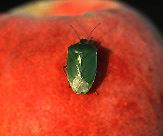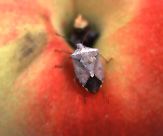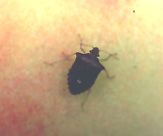
II. Hosts: SB are found on a variety of hosts in addition to peaches. Hosts include many broadleaf weeds, especially legumes, as well as crops such as soybeans and snapbeans.
III. Description: SB are broad insects with a flattened, shield shaped body, and a narrow head. The green SB (pictured above and top left below) is the largest in this complex, attaining a length between 5/8 and 3/4 inch (16-19 mm). The brown SB (top right below) is brown to grayish-brown, slightly speckled, and about 1/2 inch (13 mm) long. Dusky SB (bottom photo below) is dark brown and slightly smaller, about 3/8 inch (9 mm) long. There is a small, sharp projection on either side of the shoulder, or prothorax. An additional species, the southern green stink bug, Nezara viridula (L.), can be differentiated from green stink bug by its red (versus black) bands on antennae, and by shape of scent glands ventrally.



IV. Biology: Adults overwinter in protected areas such as fence rows, under dead weeds, ground cover, or stones, and in the bark of orchard and other trees. SB become active during the first warm days of spring. They may be seen as early as bloom through shuck-fall. The green SB has one generation per year, while the brown and dusky species have two generations per year. Green SB activity peaks in mid to late June and tapers off through July and August. Brown and dusky SB may show peaks of activity from May through June, but little activity in July. Populations increase again during a second generation in late July to August. Adults are strong fliers and will readily move between weeds and other alternate hosts, and peaches. Ground cover practices that eliminate seed heads and broadleaf weeds help minimize stink bug populations.
V. Injury: Since nymphs are not winged, it is largely the adults which injure fruit. Early feeding during bloom through shuck split will cause the flower or developing fruit to abort. Feeding from the shuck fall stage until fruit is about 1 inch (25 mm) in diameter will cause a deep catfacing much like that seen from TPB. Feeding on larger fruit during mid to late summer may cause various types of damage (see photos below). There are four types of injury possible. Brown and dusky SB feeding will result in brown, fuzzless, depressed corky areas similar to TPB. Fresh injury may appear as small bleeding spots of gum exuded out as droplets or strings. This may or may not be accompanied by small water-soaked areas, which are dark green areas on the skin, characterized by a water-marked appearance up to several mm deep. Green SB may exhibit a behavior of multiple probing and feeding at many sites on a single fruit. Immature fruit will appear dimpled, and mature fruit will have depressed lines and multiple corky areas resulting in a gnarled and mottled appearance. In cane berries, stink bugs feed between the druplets and can cause collapse of drupelets (see the stink bug feeding, and a drupelet with feeding punctures an all sides in the linked PDF).
VI. Monitoring: Monitoring for SB can be done by those methods used for tarnished plant bugs, between petal fall and shuck fall. These include direct tree examinations, jarring or beating tray counts, orchard floor sweep sampling, and fruit damage counts. Beating tray sampling is done with a framed white sheet placed on the ground beneath the tree, or with a hand held square yard canvas beating tray, made for this purpose. One or two branches 3/4 -1 inch (19-25 mm) in diameter are beaten with a rubber mallet or heavy stick wrapped with rubber three or four times, or shaken abruptly. Insects that land on the cloth must be counted immediately.
Sweep sampling can be done as outlined for TPB, and targeted for all catfacing insects present in the ground cover. Sampling should be done with a heavy duty sweep net, taking at least 50 sweeps encompassing 180ƒ per sample site, or per block. Sampling should be biased towards the thicker ground cover and weeds that are blooming or have seeded.
Fruit may be monitored as outlined under TPB
monitoring. Both old and new feeding should be recorded so that
management programs can be adjusted or changed if needed. There
are no action thresholds based on SB monitoring. The same
considerations given for TPB monitoring and control apply to SB.